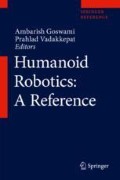Abstract
In this chapter, NAO, the most sold humanoid robot throughout the world, is introduced. Originally designed to be a domestic companion, this 58 cm tall bipedal robot was first adopted by researchers and educators. These academic communities greatly appreciate using NAO as a platform on which they can easily develop applications. Thanks to its humanoid shape, NAO changes the focus of robotic research development and highlights how human-machine interaction is a major issue for the acceptability of the robots in our daily environment. After a brief history of NAO, the kinematics, the actuators, the sensors, and the architecture of the robot will be presented. On top of this hardware, a software environment is also available. It is based on NAOqiOS, a specific framework which gives the user access to the robot’s resources: data from the sensors and control data of the actuators as well as high-level features like walking, face recognition, speech recognition, and dialogue capabilities. The services provided by NAOqiOS are accessible in Python and C++ but also through Choregraphe, a graphical programming interface that offers a very intuitive way to develop robotic applications without deeper programming skills. Some of the applications already available on NAO are presented below. The future applications of companion robots will require tackling technological challenges as well as answering ethical questions.
Access this chapter
Tax calculation will be finalised at checkout
Purchases are for personal use only
References
H. Kitano, M. Asada, Y. Kuniyoshi, I. Noda, E. Osawa, Robocup: the robot world cup initiative, in Proceedings of the First International Conference on Autonomous Agents (ACM, New York, 1997), pp. 340–347
D. Gouaillier, V. Hugel, P. Blazevic, C. Kilner, J. Monceaux, P. Lafourcade, et al., Mechatronic design of NAO humanoid, in Robotic and Automation ICRA 09 (IEEE, Kobe, 2009), pp. 769–774
Aldebaran, doc.aldebaran.com 2014, Récupéré sur http://doc.aldebaran.com/
S. Kajita, F. Kanehiro, K. Kanzko, K. Fujiwara, K. Harada, K. Yokoi, et al., Biped walking pattern generation by using preview control of zero-moment point, Robotics and Automation (ICRA2003) (IEEE, Taipei, 2003), pp. 1620–1626
R. Gelin, O. d’Alessandro, Q.A. Le, O. Deroo, J.C. Martin, S. Rosset, Towards a storytelling humanoid robot, in AAAI Fall Symposium : Dialogue with Robots, Arlington, 2010
E. Pot, J. Monceaux, R. Gelin, B. Maisonnier, Choregraphe: a graphical tool for humanoid robot programming, in Robot and Human Interactive Communication, RO-MAN 2009 (IEEE, Toyama, 2009), pp. 46–51
Aldebaran, Developer Community (2015), Récupéré sur https://community.aldebaran.com/
R. Baddoura, G. Venture, Social vs. useful HRI: experiencing the familiar, perceiving the robot as a sociable partner and responding to its actions. Int. J. Soc. Robot. 5(4), 529–547 (2013)
Teleoperation, (s.d.). https://www.youtube.com/watch?v=_7nGBi3a9YA
M. Villano, C. Crowel, K. Wier, K. Tang, B. Thomas, N. Shea, et al., DOMER: a wizard of oz interface for using interactive robots to scaffold social skills for children with autism spectrum disorders, in Proceedings of the 6th International Conference on Human-robot Interaction (ACM, 2011), pp. 279–280
O. Joubert, L’enfant autiste, le robot, et l’enseignant : une rencontre sociétale. Enfance 2015(1), 127–140 (2015)
C. Kidd, W. Taggart, S. Turkle, A sociale robot to encourage social interaction among elderly, in International Conference on Robotics and Automation (ICRA 2006) (IEEE, Orlando, 2006), pp. 3972–3976
A. Pandey, R. Gelin, R. Alami, R. Viry, A. Buendia, R. Meertens, et al., Romeo2 project: humanoid robot assistant and companion for everyday life: I. Situation assessment for social intelligence, in International Workshop on Artificial Intelligence and Cognition (CEUR, Torino, 2014), pp. 140–147
Aldebaran. Store 2015, Récupéré sur https://store.aldebaran-robotics.com/
M. Dissanayake, P. Newman, S. Clark, H. Durrant-WWhyte, M. Csorba, A solution to the simultaneous localization and map building (SLAM) problem, in Robotic and Automation (ICRA 2001) (IEEE, Seoul, 2001), pp. 229–241
E. Wirbel, B. Steux, S. Bonnabel, A. de la Fortelle, Humanoid robot navigation: from a visual SLAM to a visual compass, in Networking, Sensing and Control (ICNSC) (IEEE, Evry, 2013), pp. 678–683
L. George, A. Mazel, Humanoid robot indoor navigation based on 2D bar codes: application to the NAO robot, in Himanoid Robots (Humanoids) (IEEE, Atlanta, 2013), pp. 329–335
J. Martell, G. Gini, Robotic hands: design review and proposal of new design process. World Acad. Sci. Eng. Technol. 20, 85–90 (2007)
D.A.G. Jauregui, P. Horain, Real-time 3D motion capture by monocular vision and virtual rendering, in Computer Vision (ECCV2012) (Springer, Firenze, 2012), pp. 663–666
A. Buendia, L. Devillers, From informative cooperative dialogues to long-term social relation with a robot, inNatural Interaction with Robots, Knowbots and Smartphones, ed. by J. Dans Mariani, S. Rosset, M. Garnier-Rizet, L.. Devillers (Springer, New York, 2014), pp. 135–151.
D. Gouaillier, C. Collette, C. Kilner, Omni-directional closed loop walk for NAO, in Humanoid Robots (Humanoids 2010) (IEEE, Nashville, 2010), pp. 448–454
M. Khedher, M. El Yacoubi, B. Dorizzi, Human action recognition using continuous HMMs and HOG/HOF silhouette representation, in International Conference on Pattern Recognition and Methods (ICPRAM 12) (SciTePress, Algarve, 2012), pp. 503–508
Author information
Authors and Affiliations
Corresponding author
Editor information
Editors and Affiliations
Rights and permissions
Copyright information
© 2019 Springer Nature B.V.
About this entry
Cite this entry
Gelin, R. (2019). NAO. In: Goswami, A., Vadakkepat, P. (eds) Humanoid Robotics: A Reference. Springer, Dordrecht. https://doi.org/10.1007/978-94-007-6046-2_14
Download citation
DOI: https://doi.org/10.1007/978-94-007-6046-2_14
Published:
Publisher Name: Springer, Dordrecht
Print ISBN: 978-94-007-6045-5
Online ISBN: 978-94-007-6046-2
eBook Packages: Intelligent Technologies and RoboticsReference Module Computer Science and Engineering

